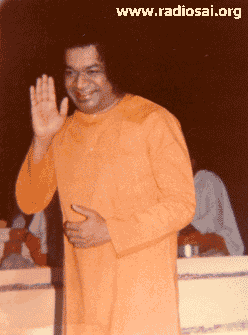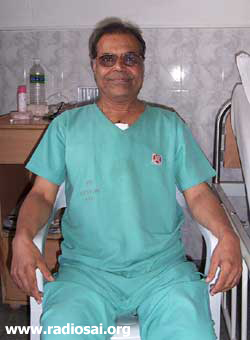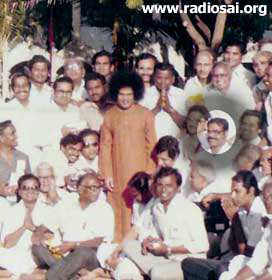 |
 |
 |
 |
| Volume 4 - Issue 10 OCTOBER 2006 |
|
WHERE LOVE IS THE THERAPY….. And Faith Is The Remedy - By Sri Y Arvind “How many cases for tomorrow, sir?” asked the Technical Officer while working on a presentation at his notebook computer. Dr. Anil Kumar opened the preoperative ward register. “Well, since it is a Saturday, we could have only two pumps with the academic sessions.” “Alright, sir, but nothing serious, I hope.” “No, just straight forward pumps" [surgeries involving the heart/lung machine] "but actually,” the Doctor continued, “we have a really good case in the ward, a coronary" [ a generic term for a patient with blocked heart arteries]. The officer raised his hand in mock protest “But not for tomorrow, for Monday.” The officer relaxed and continued working on the presentation. Dr. Anil Kumar focused on the Operation Theater List for the next few days. He had to draw a balance between resource and operation, optimizing the former to maximize the latter. Silence reigned as they worked.
“Well, sir, our Hospital caters to one and all alike. We make no distinctions. Every patient has an equal opportunity.” The officer paused and then said slowly, “Is that what you mean?” “Correct,” replied Dr. Anil Kumar, leaning back in his chair. “But we come into the picture only after the patient comes to us. The decision to come here or go elsewhere is theirs, right?” “That may be so, sir. But in this world, people feel that nothing comes free, and if it is free, they suspect there is a catch. There are some who say that since we are offering free medical care…” He raised his hands and shrugged. “They feel we compromise, we don’t do quality work.” “We don’t have to prove anything to anybody,” said Dr. Anil Kumar. “Our work speaks for itself. Five years here and fifteen in Parthi. Look at our record: free service is not only possible, it is sustainable,” emphasizing the last word. He picked up a case file. “Look at this patient. A professor of pathology from Orissa. The surprising thing is he can afford to have this surgery done anywhere and his own Institution will do it for him but he comes here. What brought him here as opposed to the other premier institutions in the country?” The officer nodded his head thoughtfully. “So,” continued Dr. Anil Kumar, “We need to find out more about this professor. His name…” he looked at the register, “is Dr. Radheshyam Hota. Why don’t we have a chat with him now?” “It’s late, sir.” The wall clock said 8:00 p.m. “He’ll probably be resting after his dinner.” “I’m going to the pre-operative ward now anyway, so join me in five minutes and I’ll introduce you and you take over from there,” Dr. Anil Kumar instructed while closing the pre-op register with finality.
Why do anomalies exist in a perfect world? When God is perfect why is the world imperfect? the officer pondered “There is not anomaly in creation, it is the anomaly of vision,” the words of Sri Sathya Sai Baba echoed in reply. Vision? What vision? This is reality. How can reality be a vision? “Reality is as real as you want it to be. You are not what you think you are. You are a child of immortality.” Then why is there so much suffering? Why am I blessed to be healthy while there are so many others who are suffering? “You are indeed blessed to be healthy, so that you may serve those who are suffering. This body has been gifted to you to serve others and perform your dharma.” Questions and answers meandered through the mind of the officer as his eyes took in the sights in the ward. From the simple-minded to the most erudite, a doctor is in a class of his own, particularly if he holds the key to the well-being of one’s loved one; in that case, the respect increases manifold. This feeling was most apparent when the pair, Dr. Anil Kumar and the officer, entered the ward. As if by silent command, the noise in the playpen stopped and the children quickly scrambled onto their beds. Those that were walking about returned to their beds and the ones lying down sat up. There was a hushed feeling of silent respect. The Doctor had come. Dr Hota – Amazing Faith “Dr. Radheshyam Hota. Admitted for coronary artery disease, please,” said Dr. Anil Kumar to the sister at the nursing station. Quickly referring to a list on her desk she directed them to the last cubicle on the left of the ward. They traversed the length of the ward and found Dr. Hota seated on his bed reading a magazine.
Dr. Hota replied unhesitatingly, “This is Swami’s Hospital and I know I will receive the best quality treatment here.” The words rang clear and honest. They had come from a medical professional who had seen the best in the country, who could afford the finest treatment, yet he had chosen to come to Swami’s Hospital because he was convinced that he would receive quality treatment there. Dr. Anil Kumar looked at the officer and nodded. “The officer here would like to know more about you. Spend some time with him, if you don’t mind.” The last few words were to Dr. Hota, who nodded with a smile on his placid face.
He had a heart attack. Dr. Hota was diagnosed with a 99% block in the LAD. [Left Anterior Descending, an artery supplying blood to the heart.] The clinical diagnosis read as the first anterior wall MI [Class II Ischemic heart disease]. Final diagnosis was: CAD – S/P AWMI: Coronary Artery Disease, blocks in the arteries supplying blood to the heart, Anterior Wall Myocardial Infarct. When the upper surface of the heart does not receive sufficient blood for a long period of time it stops beating. When it stops, it is a heart attack. Dr. Hota narrated what happened that day. “I was urgently summoned to the hospital to issue blood to a patient. I issued the blood and was about to return home when suddenly I developed severe chest pains. The Medicine Specialist prescribed some medication but the pain did not abate. An important function was to be held over the next few days in which the Governor was to preside and since protocol demanded my presence as the Blood Bank Officer, I wanted to be fit enough to attend the function." “I immediately went to a reputed medical college where the doctor refused to see me as it was not an out-patient day. I was quite taken aback by his attitude.” The doctor, instead of treating him, referred him to the Emergency Department. “I was desperately waiting for medical attention at Emergency when I had a myocardial infarction [heart-attack]. Thankfully, another doctor arrived and I was promptly given streptokinase and hospitalized for three weeks.”
.“Though being a doctor, I wasn’t very comfortable with my fellow doctors’ diagnosis. I didn’t want to rush in for the angioplasty. I needed a second opinion, and where else can we turn but to Swami.” Dr. Hota’s faith in Swami was so strong that he immediately came to Puttaparthy for consultation with the doctors in Sri Sathya Sai Institute of Higher Medical Sciences, Prashanti Gram, Swami’s first Super Specialty Hospital, inaugurated in 1991.
An angiogram was subsequently done, which showed multiple blocks in the LAD and other arteries. The doctors decided that he would need to undergo a coronary artery by-pass surgery. In early July, Dr. Hota was admitted to the pre-operative ward. Just before his surgery, he sent a letter to Swami. Sure enough, the surgery went off smoothly, under the expert guidance of Dr. Anil Kumar Mulpur, HOD, CTVS Department. After an uneventful recovery and a successful discharge, Dr. Hota is back at his work as before. Golden Chances in the Good Old Days Unlike many other patients who come to the Hospital first and only then hear about Him, Swami had entered Dr. Hota’s life many years ago, before the temples of healing came into existence. He was a long-time devotee and an active worker in the Sai movement in Orissa. “I heard about Swami in 1975 when I was posted in a remote part of Orissa. Having heard of Him, I first came to Parthi to participate in the 50th Birthday celebrations,” recalled Dr. Hota. “I vividly remember Swami giving the first aerial darshan in a helicopter that year. Since then I’ve been coming to Baba almost once a year or every other year. I’ve been very fortunate to have had close physical interaction with Him in those good old days, when access to Him was much easier."
“I also attended a number of World Conferences, and sevadal conferences at Puttaparthi. In 1984, I attended the large-scale medical camp conducted in over 100 villages around Puttaparthi on the eve of the Birthday celebrations that year. These medical camps were generally conducted under the guidance of Dr. Bapi Raju and they used to be inaugurated by Swami in the Poornachandra Auditorium. It was during these times that Baba distributed thermometers to the doctors,” he said, remembering the special times he had with Baba.
Where Love Is The Therapy…. “Paropakaaraartham idam shareeram” …“This body is for the service of others,” say the Upanishads. Swami has said many times, “You do My work and I will do yours, and My work is to serve your fellowman. Help ever hurt never, Love all, Serve all.” The Sri Sathya Sai Institute of Higher Medical Sciences embodies this spirit of selfless service. Dr. Hota has lived a full life, performing admirably well in every role destiny has granted him. His opinion about the Hospital is reflected in his words:
Dear Reader, how did you like this story? Would you like more of such patient stories in this section of our magazine? Do you have any suggestions for our 'Healing Touch' section which will help you better? Please let us know at h2h@radiosai.org. Please mention your name and country when you write to us. – Heart2Heart Team |
| You can write to us at : h2h@radiosai.org |
Vol 4 Issue 10 - OCTOBER 2006
|
Best viewed in Internet Explorer - 1024 x 768 resolution. |
DHTML Menu by Milonic. |







